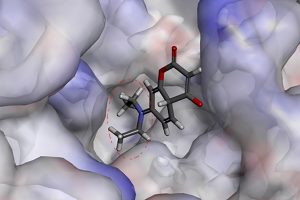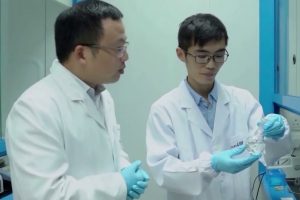The latest technology developed by the University of Macau (UM) is expected to bring a breath of hope for patients suffering from chronic liver disease! Long-term presence of acute and chronic hepatitis can cause liver fibrosis, which can progress to cirrhosis or even liver cancer. In view of this, a research team led by Wang Chunming, an associate professor of the Institute of Chinese Medical Sciences at UM, developed a new technology for early detection of fibrotic markers. Mouse models have shown that this technology can achieve high-sensitivity detection of tissue fibrosis, and has the potential to be applied to liver fibrosis detection, so that patients can receive early treatment. The study has been published in the top international journal Nature Communications.
The article is titled ‘A pocket-escaping design to prevent the common interference with near-infrared fluorescent probes in vivo’. In performing a research project initially aimed at wound repair, the UM team accidentally found that fluorescent probes commonly used for biological detection have a class of chemical groups that are easily trapped by the ‘pockets’ of proteins. This trapping generates interference signals but is mostly overlooked. Based on this mechanism, the researchers performed a ‘surgical operation’ on the standard structure of commercial dyes that have been used for decades. They designed and synthesised a completely new dye that can exert the desirable function without falling into the protein pockets and, eventually, demonstrate higher resolution than existing products. The team continued to design a new near-infrared probe that successfully detects fibrotic markers by targeting the overproduces allysine during liver fibrosis.
According to Prof Wang, the current fluorescence imaging probe can help doctors realise real-time, non-invasive, and dynamic monitoring of the development of a disease. However, when this tool is applied, it can easily bind to albumin in the blood, causing false positive signals to interfere with the detection. The technology developed by the UM team successfully solved this problem by designing and synthesising a completely new dye that can exert the desirable function without falling into the protein pockets, thereby achieving higher resolution and accuracy in the detection of fibrotic disease models. Although this new technology was developed by happenstance, the ingenious scientific design and excellent experimental data show that it can be further developed into a new fluorescence imaging technology with valuable applications in real-time diagnosis of diseases.
Nature Communications is a comprehensive sub-journal of Nature, one of the most recognisable scientific journal in the world. It publishes cutting-edge original research studies by scholars in different disciplines and in different countries, with an impact factor of 11.880 (2018). The UM study was supported by the Macao Science and Technology Development Fund and UM’s research grant. Prof Wang is the corresponding author of the study, and PhD student Xing Panfei is the first author. The following individuals have also made important contributions to this study. They are Niu Yiming and Wang Zhenzhen, postdoctoral scholars generously supported by the UM Macao Postdoctoral Fellowship and Associateship programme; Mu Ruoyu and Xie Daping, doctoral students at UM; and Prof Dong Lei and postgraduate student Li Huanling at Nanjing University. Details of the study can be found at: https://www.nature.com/articles/s41467-020-15323-8.
Source: Institute of Chinese Medical Sciences
Media Contact Information: Communications Office, University of Macau
Albee Lei Tel:(853) 88228004Kelvin U Tel:(853) 88224322Email:prs.media@um.edu.moUM Website:www.um.edu.mo



